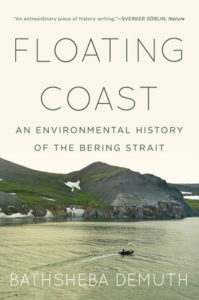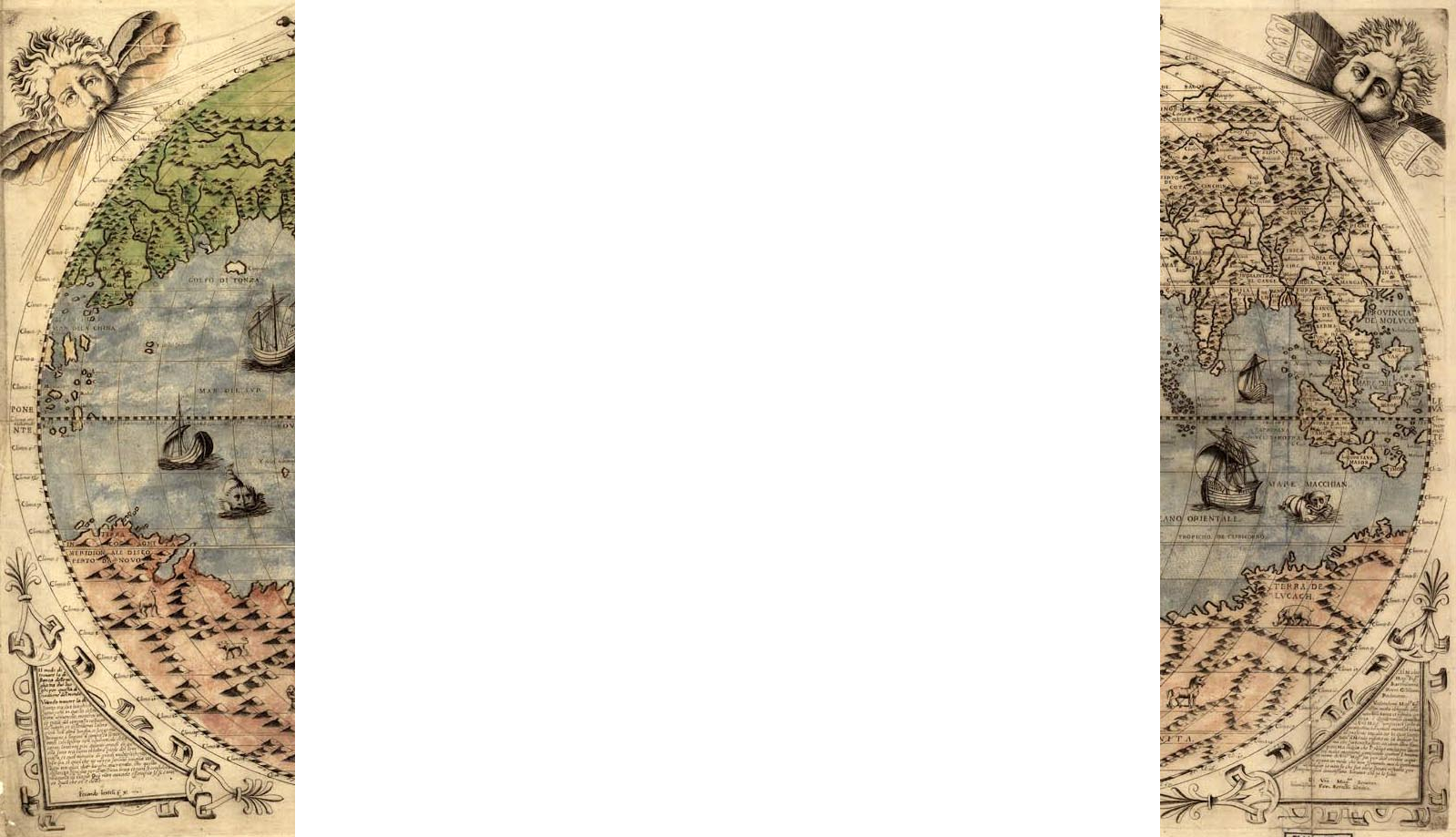Bathsheba Demuth, Floating Coast: An Environmental History of the Bering Strait (W W Norton & Company, 2019). $36.95 Hardcover; $23.95 Softcover, ISBN: 9780393358322.
By Erin Becker
 Though the Arctic was once seen as a place of boundless economic potential with numerous untapped natural resources, production—both natural and manufactured—in Beringia has always been guided by capacity of the environment and the nature of interactions of human, animal, and the natural world. At its core, Floating Coast: An Environmental History of the Bering Strait is about relationships—the relationships between people and their environment, people with each other, and humans with animals. Historian Bathsheba Demuth examines the commodification of natural elements, a history of transformation, and ecological interactions in Beringia. In every chapter, she asks “how capitalism, and the attempt to escape it through socialism, function when seen not just as human endeavors, but ecological ones” (11). Demuth traces out a fascinating history which traces the transfer of energy across the tundra and across the world. She argues human life in Beringia was shaped, partially, by the way energy moved over the land and through the sea; humans also shaped Beringia by attempting to harness that energy and enclose it into the empire. In her narrative, hunger (for energy, money, etc) “brought foreigners to Beringia with conversion on their minds” and those foreigners sought to “make energy predictable and enclose space” while also bringing Beringia into “a linear, progressive idea of time”; while foreign ideas transformed Beringia, Beringia also transformed those ideas (309).
Though the Arctic was once seen as a place of boundless economic potential with numerous untapped natural resources, production—both natural and manufactured—in Beringia has always been guided by capacity of the environment and the nature of interactions of human, animal, and the natural world. At its core, Floating Coast: An Environmental History of the Bering Strait is about relationships—the relationships between people and their environment, people with each other, and humans with animals. Historian Bathsheba Demuth examines the commodification of natural elements, a history of transformation, and ecological interactions in Beringia. In every chapter, she asks “how capitalism, and the attempt to escape it through socialism, function when seen not just as human endeavors, but ecological ones” (11). Demuth traces out a fascinating history which traces the transfer of energy across the tundra and across the world. She argues human life in Beringia was shaped, partially, by the way energy moved over the land and through the sea; humans also shaped Beringia by attempting to harness that energy and enclose it into the empire. In her narrative, hunger (for energy, money, etc) “brought foreigners to Beringia with conversion on their minds” and those foreigners sought to “make energy predictable and enclose space” while also bringing Beringia into “a linear, progressive idea of time”; while foreign ideas transformed Beringia, Beringia also transformed those ideas (309).
Demuth opens her work with two observations which guide the rest of her work—1) she writes: “the world is not what we make of it, rather, it is part of what makes us; our flesh and bones, and also our inclination and hopes”, and, 2) that life on the tundra made her question, “What is the nature of history when nature is part of what makes history?” (2-3). Floating Coast is organized into five parts—each centered on a different ecological zone of Beringia and attempts at statemaking through enclosure and commodification. Throughout her narrative, she traces out the interplay of traditional Beringian interactions with the animals and land in their environment, the impact of capitalism on the land and the people, and the development of socialism. In Part I, “The Sea, 1848-1900”, Demuth focuses on the interactions around bowhead whales, Beringians, and Yankee whalers. She states, “The work of a whale is to turn this diffused energy into hundred-ton bodies” (16-17). As Yankee whalers moved into Beringia, traditional hunting practices were upended as foreigners commodified bowhead whales for the condensed energy in their blubber and the properties of their baleen; the whaling trade brought instability due to the introduction of foreign materials, foreign diseases, and the mixing of ideas. In Part II, “The Shore, 1870-1960”, Demuth turns her examination towards the coast and traces the attempts to enclose the bodies of walruses, foxes, and the people who killed them. She explores the two linked problems of statemaking in Beringia—how to harvest energy and how to enclose land so as to not deplete all life through harvesting. Walruses, an important energy resource for seasonal villages without access to bowheads, became the second most important form of energy foreigners attempted to harvest in Beringia; as the supply of walruses also proved precarious, foreigners turned to fox fur “to manage profits without blubber” (83). Demuth places emphasis on the impact of time—she states “while dollar value might make fur seem the same as blubber or ivory, the rhythms that governed their creation were not equivalent; the market’s habit of supplanting one desire for another did not apprehend how a fox would never live on the same time as a walrus” (100-101).
In Part III, “The Land, 1880-1970,” Demuth discusses reindeer. She argues, “By 1930, foreigners on both sides of the Bering Strait saw reindeer as a way to reclaim useful energy from recalcitrant ground and make useful citizens from uncivilized people ” (166). THe US Reindeer Service wanted to create yeomen reindeer herders and the Soveit Union wanted to increase reindeer production as a measure of success of the sovkhozy. Demuth’s work on reindeer reveals that both the United States and the Soviet Union expected “tame reindeer to liberate people from stochastic waves of growth and death”, but that this desire rested on economic ideals in a world controlled by the climate—not solely by human labor (171). In Part IV, “Underground, 1900-1980”, Demuth examines the deposits of gold, lead, silver, tin, zinc, and copper in Beringia. She argues ““Making land into private property is a process of reducing the claims on its resources, its waters and soils and creatures, to one legal being, human or corporate. When land is enclosed, even temporary use by others to hunt or fish or mine requires permission of the singular owner” (212). Ultimately, Demuth asserts that one of the most important new resources of the underground was “that of national myth: Chuktoka as real, existing socialism, Alaska as the last frontier” (252). In the final part of the book (V), “The Ocean, 1920-1990”, Demuth discusses the creation of new factory ships with powerful motors, explosive harpoons, refrigerators, boilers, winches, pressurized hooks, hoses. She states that “The new factory ships were mobile disassembly lines, able to work anywhere and render any whale, no matter how thin, how huge, how distant, how quick, vulnerable. Or how rare” (260).
With stringent and far reaching attention to source material, Demuth weaves a compelling—and beautiful—narrative. She utilizes early ethnographic records, oral traditions (Yupik, Inupiat, and Chuckchi), local, regional, and national records from imperial Russia, US, and USSR, scientific materials, indigenous oral knowledge,personal observation, and biology. She states, ““This is a history that uses science, not a history of science. But to tell a history in which the songs of whales and the shapes of stones and all things in between- the spotted hawk swooping by- are part requires leaning on all ways of explaining song, stone, or swoop” (324). Demuth is particularly poised to write this narrative. She is an environmental historian who specializes in the lands and seas of the Arctic. She lived in the Yukon for several years and learned to survive in the tundra and taiga.
Floating Coast fills a gap in the historiography—it brings together many different extractive industries in Beringia into one cohesive examination with an emphasis on Beringian sources. Demuth builds upon John Bockstoce’s work in White Fox and Icy Seas in the Western Arctic: The Fur Trade, Transportation, and Change in the Early Twentieth Century (2018). Bockstoce analyzes the fur trade to examine the trading relationships guiding the securing, processing, and commercializing of the Arctic Fox Fur trade from 1899 to 1950 in the Western Arctic. While both authors look at the impact of Soviet and American competition on both sides of the Bering Strait, Demuth expands out from the fox farms to trace the impact of the declining walrus hunts on the fox fur industry and to look at the broader context of extractive industries in Beringia. With special attention paid to the impact of climate change, Demuth’s work will continue to inform our understanding of Beringia, extractive industries, and interactions with the natural world.
Sources:
John Bockstoce. White Fox and Icy Seas in the Western Arctic: The Fur Trade, Transportation, and Change in the Early Twentieth Century (New Haven: Yale University Press, 2018).
Bathsheba Demuth, Floating Coast: An Environmental History of the Bering Strait (W W Norton & Company, 2019).
Erin Becker is the Visitor Services & Volunteer Coordinator at the Long Island Maritime Museum in West Sayville, NY. Her research interests focus on the convergence of women, labor, and the environment through a global extractive maritime economy. Her work in museums grapples with investing local peoples in their resources (archaeological, historical, and environmental) as stakeholders through outreach, education, and the development of public programming. She has written for Gotham Center for New York City History, New York History Blog, Read More Science, and Global Maritime History. She is the cohost of the Scholars Beyond the Tower: Conversations from our Fields podcast. She can be found at @ErinE_Becker on Twitter.






